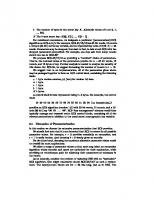RSA Encryption Algorithm in a Nut Shell
325 35 285KB
English Pages 35
Recommend Papers

- Similar Topics
- Computers
- Algorithms and Data Structures
File loading please wait...
Citation preview
RSA Encryption Algorithm in a Nut Shell.
RSA Encryption Algorithm in a Nut Shell
Abstract To analyze the RSA encryption algorithm and present a working implementation in python. We discuss the mathematical results and see why the math works. The proofs of various number theoretic results subsequently discussed are available in books mentioned in the bibliography and thus omitted. Detailed discussions on big oh notation, time complexity of basic bit operations, Euclidean and extended Euclidean algorithm, time complexity of Euclidean algorithm, time complexity of extended Euclidean algorithm, linear congruences, Euler totient function, Fermats little theorem, Euler’s theorem, the Miller-Rabin test are presented. With this mathematical background we then analyze the RSA algorithm followed by a simplifed example. Finally, the documented python code for the RSA algorithm is presented and is hoped to be of use for serious programmers who intend on implementating the algorithm on a workstation.
1
RSA Encryption Algorithm in a Nut Shell.
Index Chapter One
Ê Notation………………………………………………………………………………..04
Ê Definitions……………………………………………...……………………………..04
Chapter Two
Ê Mathematcial Background • •
Big Oh notation………………………………………………………………05
•
Rules for binary multiplication……………………………………………….07
•
Rules for binary division…………………………………………..…………08
•
Euclidean algorithm………………………………………………………….11
•
Extended Euclidean algorithm……………………………………………….12
•
Rules for binary addition……………………………………………………..06
•
Rules for binary subtraction………………………………………………….08
•
Relations and equivakence classes…………………………………………...09
•
Time complexity of Euclidean algorithm…………………………………….12
•
Time complexity of Extended Euclidean algorithm………………………….13 Linear Congruence…………………………………………………………...13 o Definition……………………………………………………………..13
•
o Cancellation law of congruence……………………………………...13
•
Relatively Prime……………………………………………………………...13
•
Euler’s Totient function………………………………………………………15
•
Time complexity of binary exponentioation modulo m….………………….16
•
Existence of multiplicative inverse………………………………………..…13
•
Algorithm for binary exponentioation modulo m………….…………………16
• • •
Introduction to Finite Field theory………………………………………..….17 o Multiplicative generators of finite field in Fp*………………………..17 Fermat’s little theorem…………………………………………………...…..18 Euler’s theorem………………………………………………………………19 Corollary of Euler’s theorem……………………………...………………….20
.
2
RSA Encryption Algorithm in a Nut Shell.
Chapter Three
Ê RSA Encryption Algorithm………………………………………………………….21 • Example of RSA encryption algorithm………………………………………22
Ê Miller-Rabin test for primality………………………………………………………23 •
Algorithm for Miller-Rabin test……………………………………………...24
Chapter Four
Ê Python code…………………………………………………………………………….25
Bibliography
3
RSA Encryption Algorithm in a Nut Shell.
Chapter One Notations Z: The set of integers. Z+: The set of positive integers. a|b: a divides b. gcd(a.b): Greatest Common divisor of a and b. O: Big oh notation. [x]: The greatest integer function. a==b: a is congruent to b a^b=ab.
Definitions Divisibility: Given integers a and b, a divides b or b is divisible by a, if there is an integer d such that b=ad, and can be written as a | b. E.g. 3|6 because 6/3=2 or 6=2*3.
Fundamental Theorem of Arithmetic: Any integer n, can be written uniquely (except for the order of the factors) as a product of prime numbers n= p1a1 * p2a2 *. . .* pnan , n has (a1+1)*(a2+1)*. . .*(an+1) different divisors. E.g. 18= 21 *32. Total number of divisors for 18 are (1+1)(2+1)=6, namely 3,9,6,18,1,2.
gcd(a,b): Given two non-zero integers a and b, their gcd is the largest integer d such that d|a and d|b. Note: d is also divisible by any integer that divides both a and b. E.g. gcd(30,15) = 15, 15|30 and 15|15, 15 is divisible by any integer that divides both (30,15). We see that 5|30 and 5|15, which means that 15 should be divisible by 5, which is true.
4
RSA Encryption Algorithm in a Nut Shell.
Chapter Two Mathematical Background
Big Oh notation
A function f (n)=O(g(n) ) or f=O(g), if there exists constants c,n0 such that f(n)= n0 Figure 1, as below shows the growth of functions f(n) and g(n). For n>=n0, we see that f(n)0): q=a/b r=a-q*b x[0]=x[2]-q*x[1]; y[0]=y[2]-q*y[1] a,b=b,r x[2]=x[1];x[1]=x[0]; y[2]=y[1];y[1]=y[0]; return [x[2],y[2]] # This function generates a random prime number by using # the algorithms specified above. def prime(bytes, init=0L): i = init # if we already know a large prime number, it # is sometimes faster to find the "next" prime # number by guessing where to start the search.
32
RSA Encryption Algorithm in a Nut Shell.
if i: i+= long(log(i)/2) else: i = rand(2**bytes) if not i%2: i+=1 # chose the first uneven number # # # #
p is the required precision for the millerrabin algorithm. For large numbers, we higher values for p to ensure that the miller-rabin algorithm returns reliable results.
p = int(ceil(sqrt(bytes)))*2 if (p > 40): p = 40 f = False # f is true if i is prime while not f: while not Fermat(i): # find a number that might be prime i += 2 if (rsa_dsp): _rsa_dsp_iter() if (rsa_dsp): out.write("!\b"); f = MRabin(i,p) # verify that it is prime if (rsa_dsp): _rsa_dsp_iter(True) return i # return the prime number # # # # # #
the keypair function returns a tuple of 2 rsakey objects which can be used for public key encryption via RSA. The bitmax paramter specifies the length in bits of the generated keys. On a 700 MHz machine, this script has already generated 8192 bit keys after a couple of hours while 4096 bits are considered secure already.
def keypair(bitmax): p = 0L; q = 0L; e = 0L; d = 0L; n = 0L bWorks = False; if (bitmax % 2): bitmax += 1 maxB = 2L ** long(bitmax/2) if (rsa_dsp): _rsa_dsp_init() # find two large prime numbers p = prime(bitmax/2) q = prime(bitmax/2, p) # calculate n=p*q and p=phi(n)=phi(p*q)=(q-1)*(p-1) # moreover, delete the prime numbers from memory # as they are not required any longer. n,p = (q*p), (q-1)*(p-1) del q while not bWorks:
33
RSA Encryption Algorithm in a Nut Shell. bWorks = True # find a random number e with gcd(phi(n),e)!=1 # it will be the encryption key (the public key) e = rand(maxB)*rand(maxB) while (p/e > 5): e=rand(maxB)*rand(maxB) while (GCD(p,e)!=1): e+=1 # calcualte the multiplicative inverse of e and # phi(n), it will be the decryption key (the # private key) sum = exeu(p,e) if ((e * sum[1] % p) == 1): d = sum[1] else: d = sum[2] # test these keys to verify that they are # valid and working if ((d>1) and (e>1) and (n0) and (ed)): for a in range(4): ascNum = rand(255) if rsa_dsp: _rsa_dsp_iter() cipher = ModExp(ascNum,e,n) if rsa_dsp: _rsa_dsp_iter() if (ModExp(cipher,d,n)!=ascNum): bWorks = False break else: bWorks = False if rsa_dsp: _rsa_dsp_iter(True) _rsa_dsp_end() e = long(e) n = long(n) d = long(d) return rsakey((e,n)),rsakey((d,n)) rsadsp(True) if __name__ == "__main__": e,d = keypair(1024) print "\nPublic Key:" print e print "\nPrivate Key:" print d raw_input()
34
RSA Encryption Algorithm in a Nut Shell.
BIBLIOGRAPHY 1. Boneh.D, Twenty years of attacks on the RSA Cryptosystem, Notices of the American Mathematical Society, February 1999.
2. IEEE P1363/D13(Draft Version 13). Standard Specifications for Public Key Cryptography, Annex A(Informative), Number Theoretical Background.
3. Neal Koblitz, A Course In Number Theory and Cryptography, Springer, Second edition, 1994.
4. William Stallings, Cryptography and Network Security, Pearson Education, Third Edition.
5. John.B.Fraleigh, A First Course in Abstract Algebra, Narosa Publishing House, Third Edition.
6. Rudolf Lidl, Harald Niederreiter, Finite Fields-Encyclopedia of Mathematics and its applications, Cambridge University Press.
7 Alfred J. Menezes, Paul C. van Oorschot and Scott A.Vanstone, Handbook of Applied Cryptography, CRC press.
8. Kolman, Busby, Ross, Discrete Mathematical Structures, Prentice Hall India, Third Edition, 1996.
9. Tom Apostol, Introduction to Analytical Number Theory, Springer International, Student edition, 1989.
10. Bruce Schneier, Applied Cryptography, Wiley Publications, Second edition, 2001.
11. Ivan Niven, Herbert S.Zuckerman, An Introduction to the Theory of Numbers, Wiley Eastern Limited. Authored by Sarad A.V aka Data. Jesko Huettenhain aka RattleSnake.
35






![A Genetic Algorithm Tutorial [jnl article]](https://ebin.pub/img/200x200/a-genetic-algorithm-tutorial-jnl-article.jpg)


